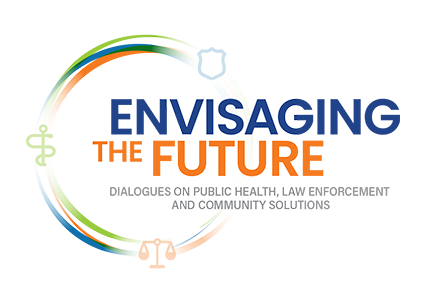by Dr Inga Heyman, Associate Professor (Policing and Public Health), GLEPHA Fellow, Edinburgh Napier University, Scotland
Prof Stan Gilmour, in his recent GLEPHA blog, laid out why a public health approach to policing benefits communities and police. Indeed, internationally there is mounting evidence of bettered outcomes for people, communities, organisations, and public sector funds where there has been a re-envisioning of working along, and across policing and public health boundaries.
Yet, despite evidence of the extensive common ground, energy, courage for change, and innovation to integrate policies and practice across police and health sectors, it can be a frustratingly slow and complex process. Embedding a cross-disciplinary field of practice is challenging. In part, this is due to disparate educational programmes, shifting organisational leadership, political agendas and limitations on evidence based cross-disciplinary research.
Crucially, we need to widen our lens beyond policing and public health, towards multisystem working. There is a need to support the advancement of collaborative policy and the preparation of people to work within and between these systems. We need to build foundations for innovation across sectors including higher education, other emergency services, citizens, NGOs, researchers, and those who fund research, local authorities, and the private sector.
Here we consider interconnected synergies and tensions in the advancing field of public health and policing. I highlight five elements for consideration in the underpinning of cross-organisational working.
- Interprofessional (IP) communication. It is stating the obvious that a lack of common language and consistency in interpretation across professions and organisations, can impede safe, innovative cross-organisational practice. Frequently, IP communication is narrowly focused on getting to grips with profession specific acronyms, jargon, and role. Yet rarely, do we receive professional preparation on effective communication in cross organisational policy and leadership – arguably key factors crucial to embedding well designed collaborative interventions. Competing organisational objectives, rank dynamics, issues around power between and within professions, and performance indicators are frequent causes of tension and communication breakdown. Positively, there is the emergence of new models of formalised, coordinated leadership across public services and communities by aligning strategies, goals, and resources. Such formalised relationships and agreements can go some way to building a platform for new cross-disciplinary understandings, address leadership shortcomings, recognition of similarity and valuing difference.
- Trust and (mis)understanding. Building trust across police and public sectors takes time. These two well established public services are steeped in different professional cultures and priorities. Yet there is a palpable urgency to create new ways of working to improve health and justice outcomes. Shrinking public sector funds has seen us retreat to further siloed working and decimate prospects of inter-professional socialisation, necessary to underpin trust and courage for change. This in turn can impact on understandings and appreciation of how, and what, each profession contributes to potential innovations in care and security. Furthermore, it can breed negative attitudes, resistance to change, question motivation and fear towards professional integrity. Indeed, this can make for a shaky footing for culture change and re-imagining of services that is sorely needed across police, health, and social care services. Furthermore, building cross-sectorial trust and understanding can be impeded by the constant shifting of local and national leadership (particularly in police services). No sooner have trusting relationships been developed, than one key partner moves position, thus loosing traction and experiential knowledge on innovative practice. The remaining partner is faced with starting over and finding the energy and drive to rebuild trust. Rather than a dependency on individuals, it is important to consider how we build resilience and deep-rooted organisational trust and understandings.
- Preparation of an interprofessional workforce to span organisational boundaries. Crucially we need to develop a work ready police, health and social care workforce who are prepared to collaborate. Yet, our practitioners are developed through separate education and practice systems. Rarely do these systems intersect. Despite interprofessional learning being a core standard for most health and social care pre-registration professional standards, learning with other front-line organisations is often spars. Educators in policing, health and social care can struggle to cover the basics of professional standards within increasingly busy curricula. In the UK for example, interprofessional education is often viewed as a luxurious extra to pre-registration health and social care education. Furthermore, there can be an educational misalignment. There is often no encouragement or structure to work across educational pillars to accommodate shared learning. Police and health educators seldom work across faculty, are often geographically separate and adopt differing pedagogical and philosophical educational approaches. Positively, there is evidence of an emerging shift in institutional culture toward more permeable boundaries to prepare police and health practitioners to work more collaboratively. For example, the development of cross-disciplinary undergraduate modules focused on criminal justice and public health, short course CPD, and police and public health post graduate studies.
- People and communities. A lack of collaborations, partnerships and data sharing can see people oscillate between health and justice systems. Yet, we are surprised, and sometimes critical of people who regularly come to the attention of multiple services. We can hear disparaging terms such as ‘frequent fliers’ used by policing and health services. Often there is an emphasis placed on how people’s behaviours, diagnosis, and backgrounds shape how they seek support. Shifting the focus from people’s behaviours, to listening to their experiences of misaligned systems, processes, and practices, goes some way to enabling services to challenge models of care and safety. Collectively we need to create an inclusive environment to identify and address cross-institutional structures and practices that create barriers to meaningful support for people and communities and improve public trust and confidence.
- International variance in the field of policing and public health. The last 15 years has seen the interest in the field of policing and public health expand considerably, with increasing support by politicians, practitioners, and academics. The GLEPHA international conference series and special interest groups, shine a light on international nuance and emerging trends in the field. These events have become the focal point to showcase, drive, and debate international development by bringing together people with shared values embodied in public safety and public health. As the field has progressed, the nuance in jurisdictions and international approaches has become more visible. Without recognition of variance, there is potential for this innovative field of practice to be stalled. For example, in the UK there has been increasing resistance to the conceptual term Law Enforcement and Public Health. Indeed, it could be argued that the term has emerged as a barrier to a public health approach to policing. Police organisations who have advanced collaborations in policing and public health, argue that the term law enforcement reflects only one part of their role. Therefore, the term policing and public health is more willingly embraced. There is a need for continued attention to national and international difference in the field. As this exciting field of practice advances and matures, we must be attentive to unintended consequences, be on the front foot, and be prepared to flex and respond to change.






